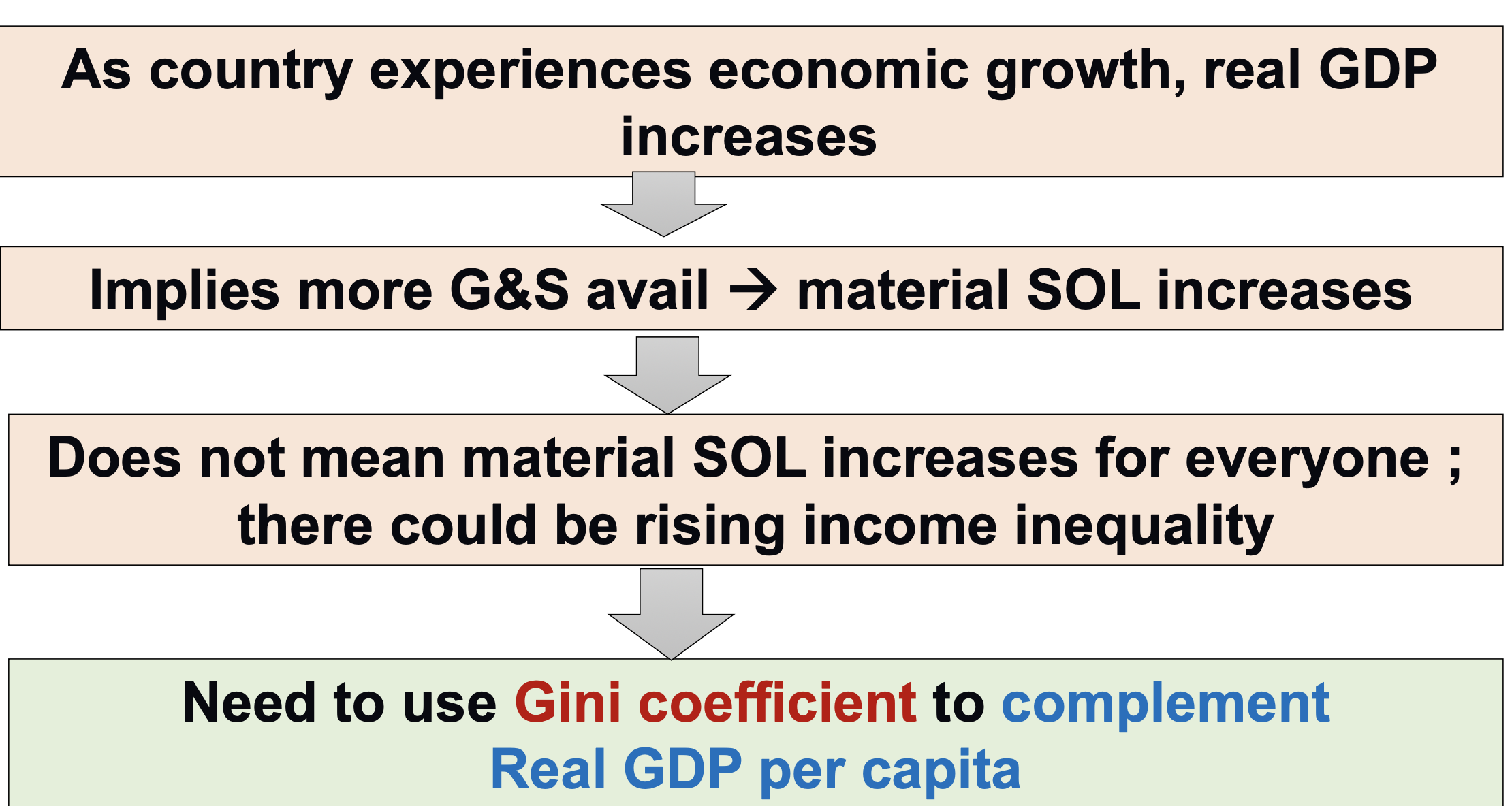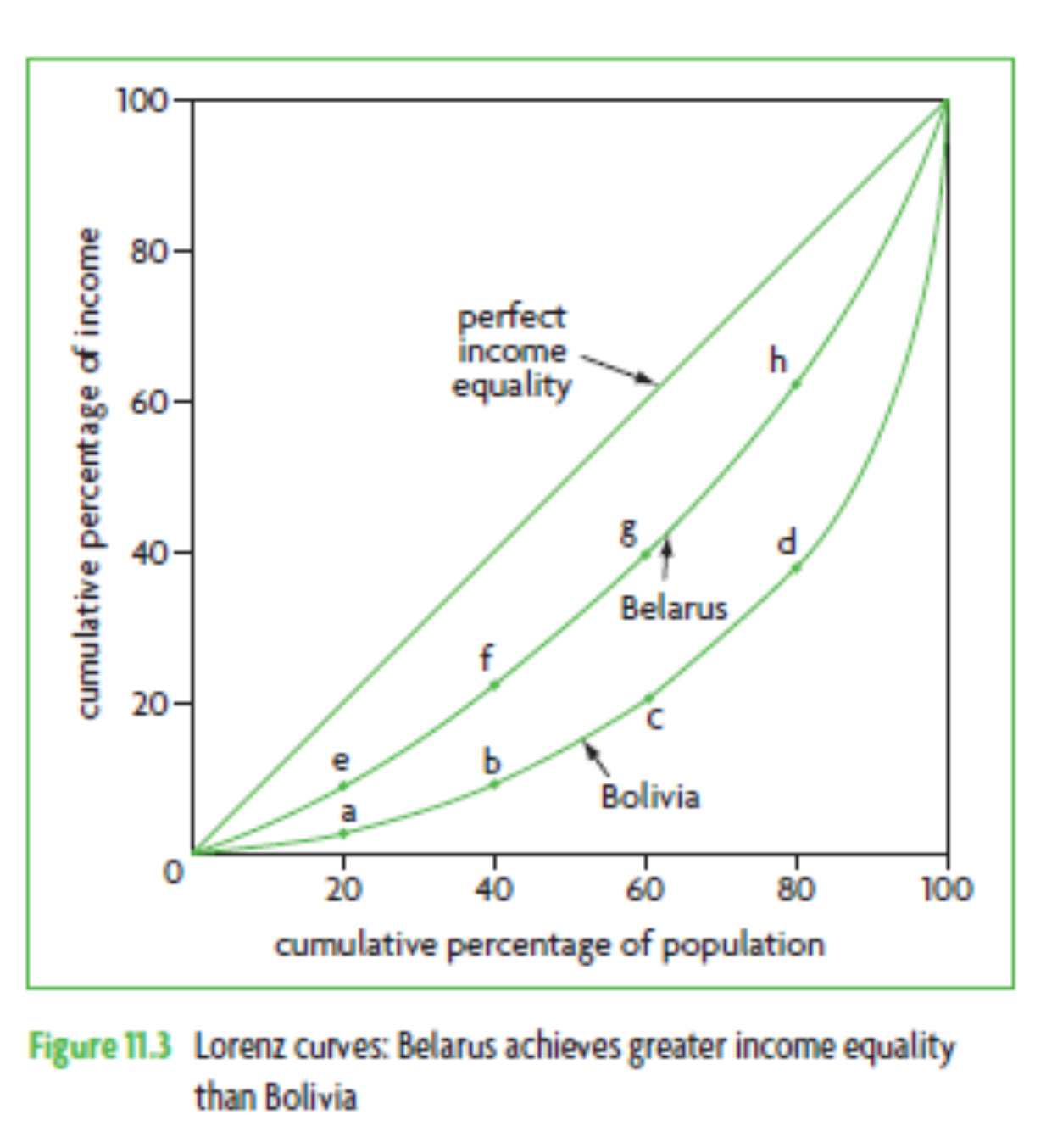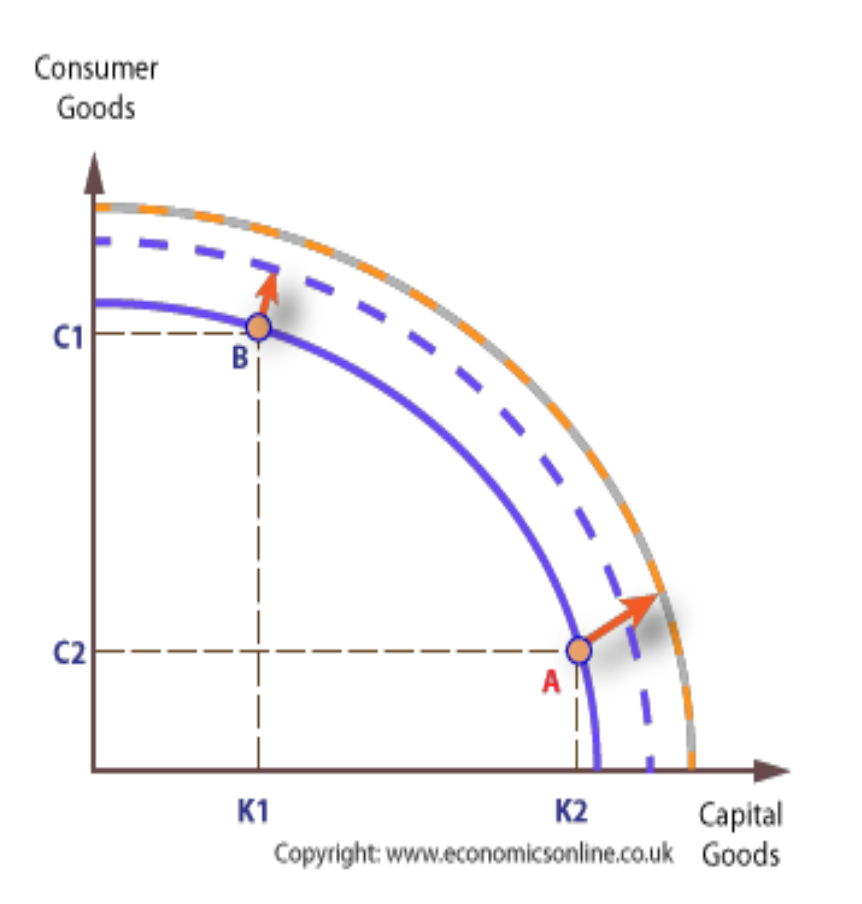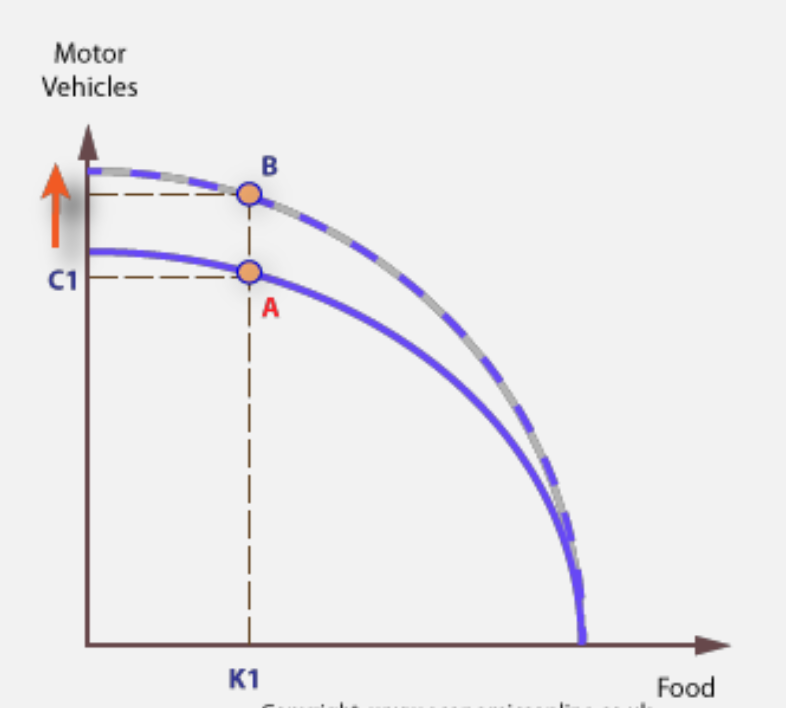Measures of Economic Activity
- There are 3 ways to measure the value of aggregate output, suggested by the circular flow of income model, all giving rise to the same result
- Expenditure approach: Adds up all spending to buy final goods and services produced within a country over a time period
- Income approach: Adds up all income earned by the factors of production that reduce all goods and services within a country over a time period
- Output approach: calculates the value of all final goods and services produced in a country over a time period
- Expenditure approach: Adds up all spending to buy final goods and services produced within a country over a time period
National Income
- National income: measures the monetary value of the flow of output of goods and services produced in an economy over a period of time
- You will not have to define this
- Main function of National Income Accounting is to provide data to analyse the overall performance of the economy
- Can be calculated in the 3 ways mentioned above
Economics Growth
- Increasing capacity of an economy to satisfy the material wants of the population
- Growth is generally thought to be the most important macroeconomic objective because it determines the future opportunity set of the economy and enables households to achieve a higher standard of living in material terms
- Has 2 meanings
- Growth refers to an increase in the output that an economy produces over a period of time (actual growth)
- Growth also refers to an increase in what an economy can produce if it is using all its scarce resources (potential growth)
- An increase in potential growth can be shown by an outward shift in the PPF curve
Gross Domestic Product
- The most frequently use measure of economic performance is the Gross Domestic Product (GDP)
- Defined as the total market value of all final goods and services produced in a country over a given period of time(usually over a year)
- GDP does not measure PPF of an economy
- GDP numbers are of little importance in themselves
- Economists place importance on the rate of change in GDP (the rate of economic growth)
- Rate of growth: Percentage change in GDP growth
- The ABS and RBA often release quarterly growth rates (the rate of growth over any three month period)

- Potential Growth: The rate of increase in the capacity of the economy to satisfy the needs and wants of people in an economy
- Actual Growth: The rate of change in real gross domestic product over a given period of time
- Trend economic growth: The average rate of change in real gross domestic product over a number of years
Does GDP measure the capacity (productive capacity- Boundary of the PPF) of the economy?
- NO!
- Measuring the capacity of the economy to produce goods and services in a given period is not an easy task.
- Much easier to measure the actual value of production, income and spending in an economy over a given period of time (this is GDP)
- If an economy’s resources are fully employed there is no difference between productive capacity and actual production
- But if the economy is in recession the difference is significant
Nominal GDP vs Real GDP
-
Real GDP: Measures the money value of all goods and services produces within the territory adjusted for price changes
-
Nominal GDP: Measured at current market prices
- Any change in nominal GDP
-
Real GDP growth rate = Nominal GDP growth rate - Inflation rate
Is GDP a good measurement of growth?
- The problems of CHANGES in inflation rate and CHANGES in population size can be simply corrected if we use Real GDP per capita to compare SOL overtime in a country.
- Limitations of GDP (Real GDP per capita) as a measure of Growth:
Income Distribution
- While economic growth should bring together higher standards of living, the distribution of these benefits throughout the community is unlikely to be evenly spread.
- The people in our society who benefit most from growth tend to be-
- The owners of non-labour resources (Land, capital and eEnterprise)
- Workers in growing sectors of the economy
- Workers who are occupationally and geographically mobile
- Just because GDP per capita increases does not mean that everyone in society is better off.
- Maybe all of the increase in income has ended up in the pockets of a small section of the population.
- Despite media scrutiny in recent times, Australia’s distribution of income has been fairly stable over the past 20 years
- Economic growth over time has had little impact on the standard of living of the poorest members of our society, relative to the wealthiest.

The Gini Coefficient
- The Gini coefficient is a summary measure of income inequality, and in a Lorenz diagram is the ratio of the area between the diagonal and the Lorenz curve, to the total area under the diagonal.
- It has a value between 0 and 1;
- the closer the value is to 0, the greater the income equality;
- the closer the value is to 1, the greater the income inequality.
- the vertical axis measures the total amount of income in an economy in cumulative percentages (therefore it runs from 0 to 100%)
- the horizontal axis plots the total population in the economy, also in cumulative percentages (therefore this, too, runs from 0 to 100%).
- (‘Cumulative’ means that 20 represents the poorest 20% of the population, 40 represents the poorest 40%, and so on.)

Non-traded Goods
- GDP measures the final value of products where money is exchanged for a good or service
- Some types of economic activity add to material welfare of society but are not assigned any monetary value and hence not included in GDP
- Examples: housework; work of charities; voluntary work; do-it-yourself activities, etc.
- Hence GDP has a tendency to understate the true value of production in an economy where transactions are not officially recorded.
Determinants of Growth
With regard to determinants of growth please note that the discussion has to be clearly aligned with either
- Actual Growth or
- Potential Growth
- Determinants of ACTUAL GROWTH involve components of aggregate demand or expenditure that influence Gross domestic Product.
- The components of GDP or National Income are consumption[C] (households) + Investment [I] (Firms) + Government expenditure [G]+ Net Exports (X-M). These affect the demand side of the economy - movements within the PPF
- Determinants of POTENTIAL GROWTH involve factors the influence the quantity and/or quality of factors of production. These affect the supply side of the economy. – movements of the frontier of the PPF
What creates growth?
- When using a PPF, growth is defined as an increase in potential output over time, and illustrated by an outward shift in the curve.
- An outward shift of a PPF means that an economy has increased its capacity to produce all goods.
- The simplest way to show economic growth is to bundle all goods into two basic categories, consumer and capital goods.
- An outward shift of a PPF means that an economy has increased its capacity to produce. (Productive capacity), i.e. potential growth increases
- This can occur when the economy undertakes some or all of the following:
Technology (increase in quantity and quality of capital)
- Investment in new technology increases potential output for all goods and services because new technology is inevitably more efficient than old technology.
- Widespread ‘mechanisation’ in the 18th and 19th centuries enabled the UK to generate vast quantities of output from relatively few resources, and become the world’s first fully industrialised economy.
- In recent times, China’s rapid growth rate owes much to the application of new technology to the manufacturing process.
Specialisation (Employing division of labour)
- A division of labour refers to how production can be broken down into separate tasks, enabling machines to be developed to help production, and allowing labour to specialise on a small range of activities.
- division of labour, and specialisation, can considerably improve productive capacity, and shift the PPF outwards
New Production Methods (The How of production)
- New methods of production can increase potential output.
- For example, the introduction of team working to the production of motor vehicles in the 1980s (UK) reduced wastage and led to considerable efficiency improvements.
- Re arranging work process to improve efficiency.
Increases its labour force
- Growth in the size of the working population enables an economy to increase its potential output.
- This can be achieved through natural growth, when the birth rate exceeds the death rate, or through net immigration, when immigration is greater than emigration.
Discovers new raw materials
- Discoveries of key resources, such as oil, increase an economy’s capacity to produce.
An inward shift of the PPF
- A PPF will shift inwards when an economy has suffered a loss or exhaustion of some of its scarce resources.
- This reduces an economy’s productive potential.
- A PPF will shift inwards if:
Resources run out
- If key non-renewable resources, like oil, are exhausted the productive capacity of an economy may be reduced.
- This happens more quickly as a result of the application of ultra- efficient production methods, and when countries over-specialise in producing goods from non-renewable resources.
- Sustainable growth (rate of growth which can be maintained without creating other significant economic problems, especially for future generations) means that the current rate of growth is not so fast that future generations are denied the benefit of scarce resources, such as non-renewable resources, and a clean environment.
Failure to Invest
- A failure to invest in human and real capital to compensate for depreciation will reduce an economy’s capacity.
- Real capital, such as machinery and equipment, wears out with use and its productivity falls over time.
- As the output from real capital falls, the productivity of labour will also fall.
- The quality and productivity of labour also depends on the acquisition of new skills.
- Therefore, if an economy does not invest in people and technology its PPF will slowly move inwards.
Erosion of Infrastructure
- A military conflict is likely to destroy factories, people, communications, and infrastructure.
Natural disaster
- If there is a natural disaster, such as the 2005 boxing-day tsunami, or the Haiti earthquake of 2010, an economy’s PPF will shift inwards.
Investment and Economic Growth
- To achieve long run growth the economy must use more of its capital resources to produce capital rather than consumer goods.
- As a result, standards of living are reduced in the short run, as resources are diverted away from private consumption.
- However, the increased investment in capital goods enables more output of consumer goods to be produced in the long run.
- This means that standards of living can increase in the future by more than they would have if the economy had not made such as short-term sacrifice.
- Hence economies face a choice between high levels of consumption in the short run and the long run.
- Allocating scarce funds to capital goods, such as machinery, is referred to as real investment.
- If an economy chooses to produce more capital goods than consumer goods, at point A in the diagram, then it will grow by more than if it allocated more resources to consumer goods, at point B.
- There is a trade-off between the short and the long run. In the short run, the economy must use resources to produce capital rather than consumer goods.
- Standards of living are reduced in the short run, as resources are diverted away from private consumption.

- However, in the longer run the increased investment in capital goods enables more output of consumer goods to be produced.
- This means that standards of living can increase in the future by more than they would have if the economy had not made such as short-term sacrifice.
- To achieve long run growth the economy must use more of its capital resources to produce capital rather than consumer goods.
- As a result, standards of living are reduced in the short run, as resources are diverted away from private consumption.
- Hence economies face a choice between high levels of consumption in the short run and the long run.
Asymmetric Growth
- An economy can grow because of an increase in productivity in one sector of the economy - this is called asymmetric growth.
- For example, an improvement in technology applied to industry Y, such as motor vehicles, but not to X, such as food production, would be illustrated by a shift of the PPF from the Y-axis only.

Factor mobility
- If workers, or other resources, are moved from one sector to another, then the position of the PPF will change, with an increase in the maximum output in the industry receiving the resources, and a fall in the maximum output of the industry losing resources.
Benefits and Costs (Actual Growth)
- Economic Growth implies both benefits and costs for the average person’s standard of living (Material + Non material welfare/SoL)
- Growth implies increasing levels of real income, therefore ability to satisfy more wants.
- However, brings about costs e.g structural unemployment, inflation, environmental degradation and social dislocation
Benefits
- Economic growth is associated with a number of material benefits which increase economic welfare.
- These include the following:
- According to textbook
- Increase in real income (material welfare/SoL)
- More economic opportunities
- A taxation dividend to government
- Higher quality good and services
Higher GDP per capita
- A rise in real national income means that wages and profits are likely to rise. Assuming a stable population, this will raise GDP per capita.
More public and merit goods
- A growing economy means that the public sector can receive more tax revenue and more resources can be allocated to public and merit goods, such as more roads, hospitals and schools.
Positive externalities
- Public and merit goods generate considerable external benefits. More hospitals and schools mean a healthier and better-educated population, which generates other economic benefits in terms of the effectiveness of the labour force, and increases in long-term aggregate supply
More employment
- Growth is clearly likely to stimulate demand for labour, and it is likely that more people will be employed and fewer unemployed.
Costs
- From Textbook
- Not everyone may experience and increase in living standards
- Associated with a structural change in economy (+/-)
- Inflationary pressure (Demand Pull)
- Social Costs – eg. crime, suicide due to stress, etc.
- Associated with economic ‘bads’ as well as ‘goods’
- Environmental problems: eg pollution, congestion (negative Ext)
- Excessive Growth can lead to:
- Goods and service inflation
- House price inflation (+/-)
- Wage inflation – increase in cost of production
- Labour shortages
- Falling savings
- Excessive credit
- Trade difficulties
- Economic growth also brings some costs which reduce economic welfare, including:
Negative externalities
- As production and consumption increase, negative externalities, such as pollution and congestion, are likely to arise.
- There is also the likelihood of increased depletion of non-renewable resources, such as fossil fuels.
Inflation and balance of payments difficulties
- Too rapid a rate of growth can also lead to two significant economic problems: inflationary pressure and a balance of payments deficit, as imports rise to satisfy an increasingly active household sector.
Widening income gap
- Growth can also widen the distribution of income, because some groups may benefit much more than others.
- Certainly in the UK, the relative income gap has widened during the growth years of 1992 to 2008.
Low/Negative Growth
- Low or negative growth can lead to:
- Goods deflation
- House price deflation
- Labour surpluses
- Unemployment (Cyclical/demand-deficient)
- Excessive debt burden
- Public sector debt